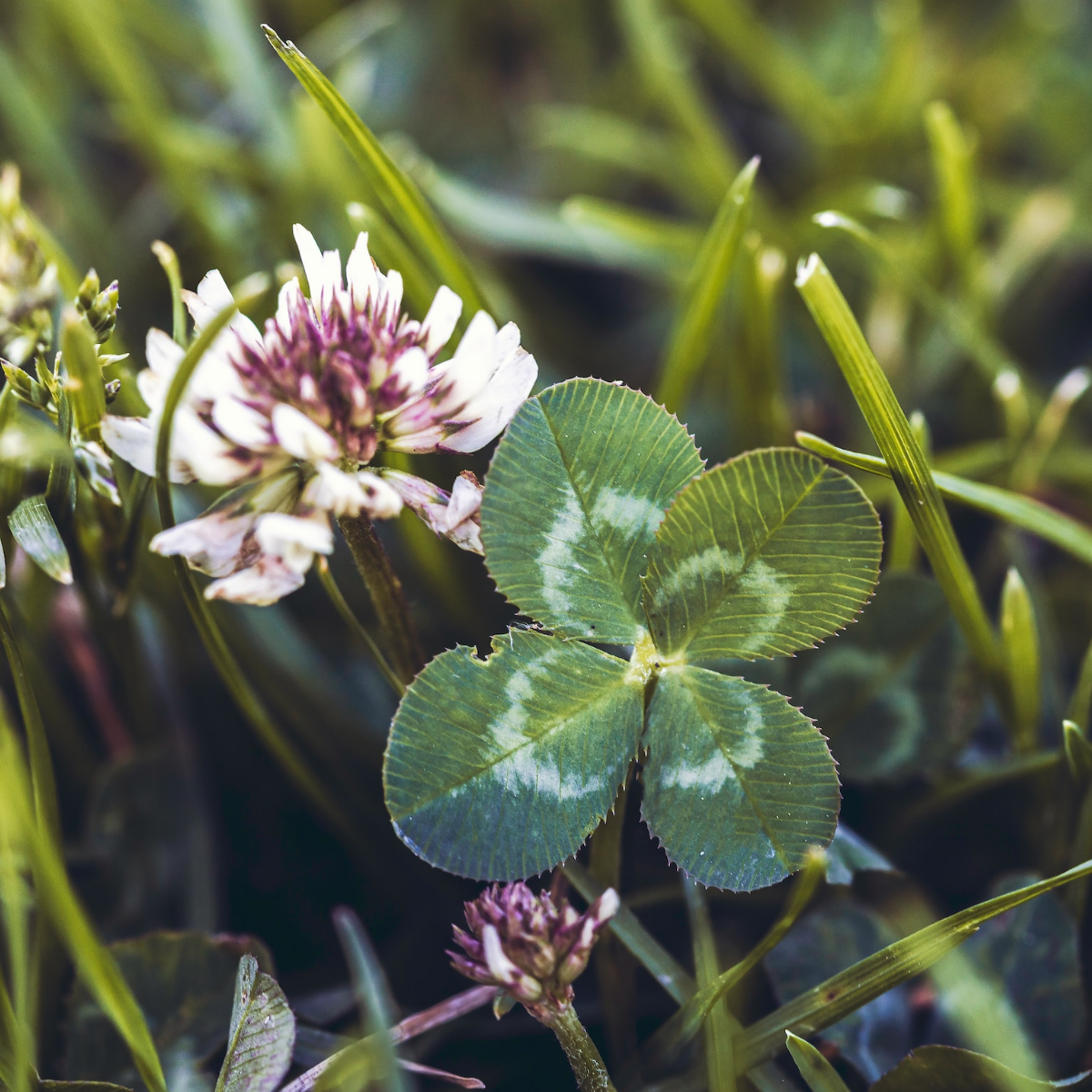Central to the plot of a short story that I’ve been revising is a four-leaf clover found by the main character after searching through a clover patch. I can remember sitting in the grass as a child, sifting through clover leaves and blossoms, hunting for a magical four-leaf clover with which I could make a wish. Yet, through my research for the story, I’ve learned that granting wishes was not the only folkloric use of a four-leaf clover. They also were utilized to see through faerie glamour, as tokens of good fortune, and in love divination.

As a quick aside, the term “four-leaf clover” seems to be the current use in dictionaries, and it will be what I use. However, I encountered “four-leaved clover” and “four-leafed clover” in both British and American sources, so when I quote from them, I will use their spellings. I searched for the etymology of the term, but I could not determine the reason for the different spellings.
Piercing Glamour With a Four-Leaf Clover
The folklorist Katharine Briggs explains in her reference work, An Encyclopedia of Fairies: Hobgoblins, Brownies, Bogies, and Other Supernatural Creatures, that the primary purpose of a four-leaf clover was to enable the person carrying it to see through glamour. Glamour was an enchantment cast by a faerie or witch that manipulated how “… things were perceived or not perceived as the enchanter wished.”
With a four-leaf clover, a mortal could see faeries and their environments as they truly were, piercing through the glamour that gave a false impression of reality. In many stories and folktales, the plucking and carrying of a four-leaf clover was unintentional and yielded a surprise viewing of faeries. For example, the tale “The Four-Leaved Clover,” found in Popular Romances of the West of England; or, The Drolls, Traditions, and Superstitions of Old Cornwall by Robert Hunt, describes a dairymaid’s accidental encounter with faeries:
One midsummer’s day in the evening, the maid was later than usual milking, as she had been down to Penberth to the games. The stars were beginning to blink when she finished her task. Daisey was the last cow milked, and the bucket was so full she could scarcely lift it to her head. Before rising from the milking-stool, the maid plucked up a handful of grass and clover to put in the head of her hat, that she might carry the bucket the steadier. She had no sooner placed the hat on her head, than she saw hundreds and thousands of Small People [faeries] swarming in all directions about the cow, and dipping their hands into the milk, taking it out on the clover blossoms and sucking them.
Within the grass and clover she used to steady her bucket, the dairymaid had unknowingly plucked a four-leaf clover, enabling her to suddenly see the faeries that had been there all along while she had milked the cow.
Faerie Ointment Granted Faerie Sight
In addition to using four-leaf clovers directly to see through faerie glamour, Briggs also describes a faerie ointment “made of sprigs of four-leafed clover.” When this ointment was wiped on the eyes, it broke through glamour and invisibility spells, essentially granting faerie sight.

There are many tales in which a human woman cares for or assists in the birth of a half-faerie/half-human child. In order for the child to see the faerie parent and faerie world, the human midwife or caretaker must “anoint” the child’s eyes with the ointment. Often she accidentally wipes her own eyes in the process (but sometimes on purpose!), thereby giving herself faerie sight.
In this way, the faerie ointment and four-leaf clovers acted as a protection for mortals against faeries. They could see and understand that they were in the presence of faeries. But often this was only a perceived protection. Breaking a glamour spell and revealing what the faerie was trying to hide often resulted in a consequence imposed by the faerie on the person who broke the spell. Briggs explains:
Once a human eye has been touched by the ointment it can penetrate fairy disguises, and this power is only removed by a blast of fairy breath or the more vindictive blinding of the seeing eye, as occurs in one of the midwife to the fairies stories.
So with a single breath, a faerie could remove faerie sight, leaving the mortal with only their human sight. This was a mild response, which seemed to be administered to those who had inadvertently used the ointment on themselves. The harsher punishment of blinding, which obviously removes both faerie and human sight, comes from a tale where a woman applies the ointment on purpose.
Wishing on a Four-Leaf Clover
Granting wishes was a secondary use of a four-leaf clover in faerie folklore. The mortal who found a four-leaf clover could use it to make a wish. Just as I had longed to do as a child! But interestingly, while researching the idea of wishing on a four-leaf clover, I didn’t really come across stories of folks hoping to better themselves or obtain a material object. Rather the wishes were for the return of a child who had been stolen by the faeries.
In an earlier article I explored the topic of changelings and the widespread belief that faeries desired human children and often took them from their parents. (For more on this topic, see my post on changelings.) Parents would employ a variety of methods to encourage the faeries to return their true child to them, some of them quite drastic.
But in the case of four-leaf clovers, I found gentler stories of children being returned with the help of this rare version of the plant. In the tale “Amelia and the Dwarfs,” from the book The Brownies and Other Tales by Juliana Horatia Ewing, Amelia is taken from her parents by the faeries because of her bad behavior, and a stock is left in her place. (Note: Ewing uses dwarf and faerie interchangeably in the story.) A human woman who is also trapped there by the faeries as their servant explains to Amelia that she has been “… a peevish, selfish, wilful, useless, and ill-mannered little miss, ….”
So Amelia learns how to wash and mend her frocks, as well as heat up scraps of food, in order to please the faeries and be sent home. However, the woman helping her isn’t so sure that will be enough. Now that Amelia is so helpful and capable, the faeries might want to keep her around. But the woman offers her a solution:
… “your only chance is this. If ever, when dancing in the meadows [with the faeries], you can find a four-leaved clover, hold it in your hand, and wish to be at home. Then no one can stop you.”

After several rounds of dancing in the meadow and searching, Amelia finally discovers a four-leaf clover. She holds it over her head and declares, “I want to go home!” Immediately she is returned to her very own bed.
In a similar vein, I found a bit of four-leaf clover folklore in W. Y. Evans Wentz’s, The Fairy-Faith in Celtic Countries. He shares portions of an interview he had with a Mr. Henry Maddern in Penzance (Cornwall). Mr Maddern described the country pixies as “a wicked sort,” who stole human children, leaving one of their own behind. He further explained that “… the true child could only be got back by laying a four-leaf clover on the changeling.”
Although Mr. Maddern does not explicitly state that the person placing the clover on the changeling also must make a wish, to me it feels like that was the intent—the hope that the four-leaf clover would ensure the return of the human child.
Good Omen and Love Divination
Interpreting four-leaf clovers as an auspicious sign for both luck and love is an area where British and American folklore overlap. So I’m including examples from both regions.
In Notes on the Folk-Lore of the Northern Counties of England and the Borders by William Henderson, he observes: “A pod containing only one pea is equally auspicious, and so is a four-leaved clover or an even ash-leaf.” (An “even” ash leaf is one with an even number of leaflets.) He also quotes lines from a “privately-printed collection of North Country Folk-Lore” that associate the four-leaf clover with finding love:
Find even ash or four-leaved clover,
An’ you’ll see your true love before the day’s over.
Martha Warren Beckwith offers similar folklore in her article, “Signs and Superstitions Collected from American College Girls.” From her interviews with forty-five college girls (of mostly European ancestry) she describes a love divination belief from the young women that resonates with what Henderson provided above:
164. If you find a four-leafed clover, you will marry the next man you meet.
Beckwith also outlines a more extensive belief system of luck related to a four-leaf clover. (In her article, she has numbered all of the signs/superstitions—186 in all. An asterisk means that the sign/superstition was recorded more than once but less than five times.) With respect to the four-leaf clover and luck, she lists the following:
*75. (a) It is good luck to find a four-leafed clover; bad luck, if you give it away.
* (b) It is bad luck to take a four-leafed clover that some one else has found; good luck, to take a five-leafed clover.
76. It is bad luck to find a five-leafed clover, but can be averted if you give it away.
I hadn’t known of the belief that bad luck could incur if you gave away your four-leaf clover. Also, have you ever found a five-leaf clover? I think I’ve only found four-leaf ones, and very few at that. According to the Guinness World Records, Yoshiharu Watanabe (Japan), grew a record-breaking 63-leaf clover in 2024!
I thought I’d close with a poem on the subject of luck, love, and a four-leaf clover. I found it in the November 1893 issue of The New England Magazine.
Luck
by Abbie Farwell Brown
I sought a four-leaved clover,—
The grass was gemmed with dew,—
I searched the meadow over
To find a four-leaved clover;
I was a lucky rover,—
You sought the charm-grass, too,
And seeking luck and clover
I found it—finding you.
As ever, thank you for reading my blog.
Photo credit (featured image): photo by Dustin Humes via Unsplash, licensed under the Unsplash License
This post was originally published on March 22, 2023.
It has been updated on March 19, 2025.




